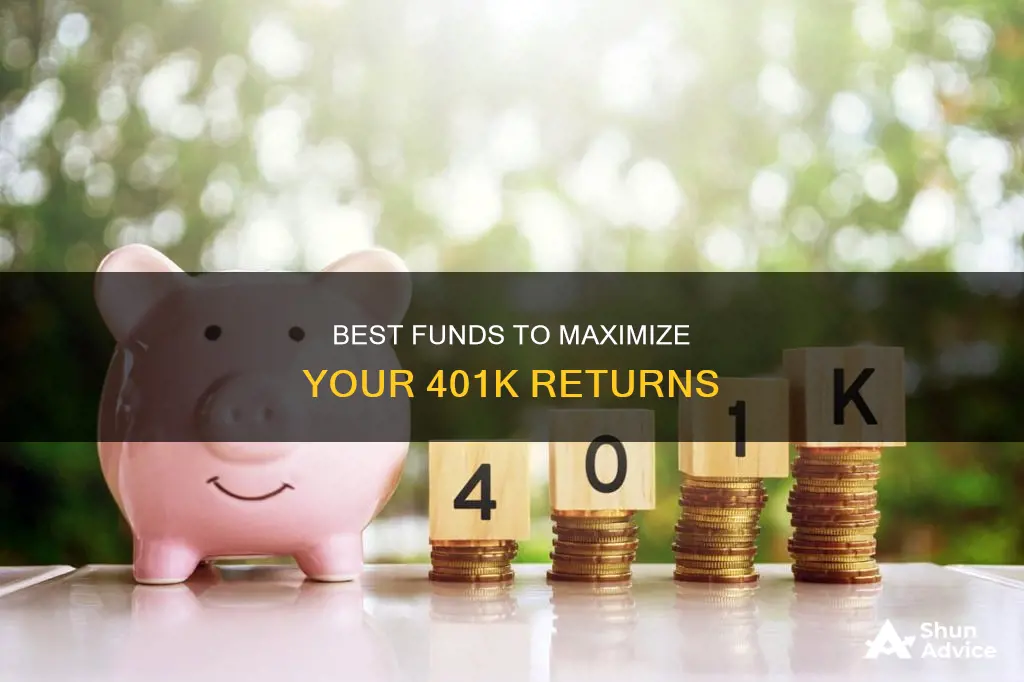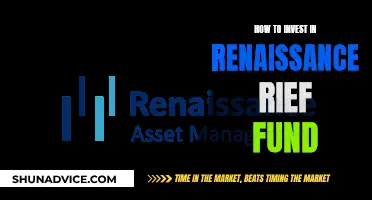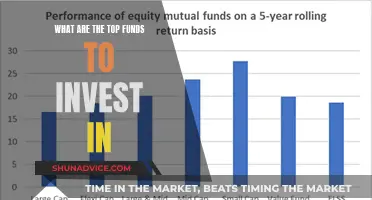
Choosing the best fund to invest in for your 401(k) can be a challenging task, with various factors to consider. Firstly, it's important to assess your risk tolerance and how much time you have until retirement. Younger investors with a higher risk appetite may opt for more aggressive growth funds, while older investors might lean towards conservative funds to preserve their capital. Diversification is also key – spreading your investments across different asset classes, sectors, and geographies can help manage risk. Additionally, it's crucial to consider fees, as high fees can eat into your returns over time. When deciding on the best fund, look for strong historical performance, low expense ratios, and a well-diversified portfolio that aligns with your investment goals and time horizon.
| Characteristics | Values |
|---|---|
| Conservative Fund | Avoids risk, sticks with high-quality bonds and other safe investments |
| Value Fund | In the middle of the risk range and invests primarily in solid, stable companies that are undervalued |
| Balanced Fund | Adds a few more risky equities to a mix of mostly value stocks and safe bonds, or vice versa |
| Aggressive Growth Fund | Always looking for the next Apple but may find the next Enron instead |
| Specialized Funds | Investing in emerging markets, new technologies, utilities, or pharmaceuticals |
| Target-Date Fund | Based on your expected retirement date, you may choose a fund intended to maximize your investment around that time |
What You'll Learn

Conservative funds
When it comes to investing in your 401(k), there is a range of options, from conservative to aggressive. Conservative funds are those that avoid risk and stick with high-quality bonds and other safe investments. While these funds offer slow and predictable growth, they are generally considered to be a good option for those who are risk-averse or approaching retirement. Here are some things to keep in mind when considering conservative funds for your 401(k):
Asset Allocation
The key difference between a conservative and aggressive 401(k) portfolio is the allocation of assets, specifically the proportion of stocks versus bonds. Conservative portfolios typically have a larger allocation of bond funds or cash-like alternatives, which are considered safer but often yield lower returns. As a general rule, the younger an investor is, the more aggressive they can afford to be, with a larger percentage of their portfolio in stocks. As an investor gets older, it is common to shift towards a more conservative portfolio with a higher percentage of bond funds.
Types of Conservative Funds
There are several types of conservative funds available, including mutual funds, index funds, exchange-traded funds (ETFs), and money market funds. Mutual funds are the most common investment option in 401(k) plans and can range from conservative to aggressive. Index funds and ETFs tend to have lower fees and are passively managed, tracking a specific stock market index. Money market funds are considered very safe but often earn little, making them more suitable for those approaching retirement age.
Advantages of Conservative Funds
Disadvantages of Conservative Funds
The main disadvantage of conservative funds is the potential for lower returns compared to more aggressive investments. If the returns do not keep up with the inflation rate, investors may lose purchasing power over time. Conservative funds may also not be suitable for younger investors who have a longer time horizon and can afford to take on more risk.
Examples of Conservative Funds
- American Funds Tax-Aware Conservative Growth and Income Portfolio (TAIFX)
- Schwab Balanced Fund (SWOBX)
- Vanguard Wellington Fund (VWELX)
- Dodge and Cox Income Fund (DODIX)
- PGIM High Yield Fund (PHYZX)
In conclusion, conservative funds can be a good option for those seeking slow and steady growth with a lower level of risk. However, it is important to consider your age, risk tolerance, and financial goals when deciding how to allocate your 401(k) investments. It is always recommended to consult with a financial advisor to determine the best investment strategy for your individual circumstances.
Index Funds: Choosing the Right Investment Strategy
You may want to see also

Value funds
A value fund is a type of investment fund that falls in the middle of the risk range. It primarily invests in solid, stable companies that are undervalued. These undervalued corporations usually pay dividends, which are typically quarterly cash payments that are expected to grow only modestly.
When it comes to investing in a 401(k), value funds can be a good option for those who want to balance risk and returns. Here are some things to consider when investing in value funds through your 401(k):
- Risk and return: Value funds are considered to be moderately risky investments. They focus on stable companies that may be undervalued by the market. By investing in these companies, value funds aim to generate returns as the market recognizes their true value. However, it's important to remember that not all undervalued companies will succeed, and there is a chance that their stock prices may not increase as expected.
- Diversification: It is generally recommended to diversify your investments across different types of assets and industries. Value funds typically invest in a range of companies, but they may have a focus on specific sectors or regions. Make sure to review the fund's portfolio and ensure that it aligns with your investment goals and risk tolerance.
- Fees and expenses: When investing in any fund, including value funds, it's crucial to consider the fees and expenses associated with the investment. Look for funds with lower expense ratios, as these can eat into your returns over time. Index funds, which track a stock market index, tend to have lower fees than actively managed funds.
- Time horizon: Value funds are often suitable for long-term investors who are willing to hold their investments for several years. The performance of value funds can vary over time, and they may go through periods of higher returns and slower growth. Consider your investment horizon and whether you are comfortable with potential fluctuations in the fund's performance.
- Company fundamentals: When investing in value funds, it's important to evaluate the fundamentals of the companies in the fund's portfolio. Look for companies with strong financial metrics, competitive advantages, and growth potential. Avoid funds that primarily invest in companies with a high risk of decline or those that are overvalued by the market.
- Asset allocation: Determine the appropriate allocation of your portfolio to value funds. Consider your overall investment strategy, risk tolerance, and financial goals when deciding how much to invest in value funds through your 401(k). Diversifying across different types of funds can help balance your risk and returns.
- Performance and track record: Review the historical performance of the value funds you are considering. Look for funds that have consistently performed well over the long term. However, keep in mind that past performance does not guarantee future results.
- Tax implications: Consider the tax implications of investing in value funds through your 401(k). Traditional 401(k) contributions are typically made with pre-tax dollars, and you will pay taxes on the withdrawals in retirement. Weigh the tax benefits of investing in a 401(k) versus other investment options, such as a Roth IRA.
- Employer match: If your employer offers a match for your 401(k) contributions, make sure to contribute enough to take full advantage of this benefit. This is essentially free money that can boost your retirement savings.
- Rebalancing: Periodically review and rebalance your portfolio to maintain your desired asset allocation. As the value of your investments in different funds changes over time, you may need to adjust your contributions or make changes to stay aligned with your investment strategy.
Who Should Invest in Mutual Funds?
You may want to see also

Balanced funds
When it comes to investing in your 401(k), there are a variety of fund options to choose from, each offering a different level of risk and potential return. One such option is balanced funds.
In terms of specific investments, a balanced fund may include a mix of stocks from different categories, such as U.S. large-cap, U.S. small-cap, international, and emerging markets. This diversification helps spread out the risk and ensures that your portfolio is not overly dependent on the performance of a single market or sector. Additionally, balanced funds may also allocate a portion of their assets to bond investments, such as a total bond market fund, to further enhance the stability of the portfolio.
When considering a balanced fund for your 401(k), it's important to evaluate the fund's risk rating, which can be found on your plan provider's website or on financial websites like Morningstar.com. Additionally, pay close attention to the expense ratios associated with the fund options, as these fees can eat into your returns over time. Opt for funds with lower expense ratios, such as index funds, whenever possible.
While balanced funds offer a more moderate approach, it's important to remember that all investments carry some level of risk. The level of risk you're comfortable with may change as you get closer to retirement, so it's essential to periodically review and adjust your asset allocation accordingly. This may involve gradually shifting from riskier investments to more conservative options as you approach your retirement years.
Bond Funds vs Individual Bonds: Which is the Better Investment?
You may want to see also

Aggressive growth funds
When considering investing in aggressive growth funds, it is important to assess your risk tolerance, age, and investment goals. Younger investors who are further from retirement may be better suited for these funds as they have more time to recoup any potential losses.
- Fidelity Growth Company K (FGCKX): This fund has delivered an impressive 10-year average return of 18.9%. While it is technically a broad-based large-cap fund, nearly 49% of its holdings are in the information technology sector.
- Fidelity OTC K (FOCKX): With a 10-year average return of 17.7%, this fund invests at least 80% of its assets in stocks traded on the Nasdaq or over-the-counter markets, providing exposure to small- and medium-sized companies.
- JPMorgan Large Cap Growth Fund (OLGAX): This fund has a 10-year average return of 17% and invests in the fastest-growing companies in the US with competitive advantages and strong price momentum.
It is important to remember that investing in aggressive growth funds carries a higher level of risk and volatility when compared to more conservative or moderate investment strategies.
Dave Ramsey's Investment Strategy: Specific Fund Choices
You may want to see also

Target-date funds
However, it's important to note that target-date funds may not always be the optimal investment strategy. They are designed with a one-size-fits-all approach, which may not align with your specific financial goals or risk tolerance. Additionally, the fees associated with target-date funds can vary, and some may have higher expense ratios than other investment options within your 401(k). Therefore, it's essential to carefully review the details of any target-date fund before investing and consider seeking advice from a financial advisor to ensure it aligns with your retirement goals.
When deciding how to invest your 401(k), it's crucial to understand your risk tolerance and the level of involvement you want in managing your investments. If you are comfortable taking on more risk and actively managing your portfolio, you may opt for a more customised investment strategy. On the other hand, if you prefer a more passive approach, target-date funds can be a convenient and hassle-free option to help you save for retirement.
Bond Fund Investment: What Percentage is Smart to Invest?
You may want to see also
Frequently asked questions
Millennials are in a great position to save for retirement, with 25 to 40 years until retirement. It is recommended that millennials invest in low-cost, well-diversified equity funds. As they get closer to retirement, they should shift to more conservative funds, such as bond funds. Some specific funds that may be suitable for millennials include an S&P 500 index fund, an emerging markets fund, and an international fund.
Some of the best-performing 401(k) funds from the past decade include a mix of active and passive funds that span various investment strategies. Here are a few examples: Fidelity Select Semiconductors Portfolio (FSELX), Vanguard Information Technology Index Admiral Shares (VITAX), and Fidelity Blue Chip Growth Fund (FBGRX).
Young adults who have many years until retirement should focus on more aggressive 401(k) investments, such as stock funds, as they can provide superior long-term growth. Some recommended funds include target-date funds, S&P 500 index funds, and small-cap funds.
The best investments for a 401(k) depend on your individual circumstances and goals. If you are early in your career and have a long time until retirement, you may prefer more aggressive stock funds that offer strong long-term growth potential. As you get closer to retirement, you may want to shift to more conservative options, such as dividend stock funds or bond funds, to protect your accumulated savings. Target-date funds can also be a good hands-off investment choice.







